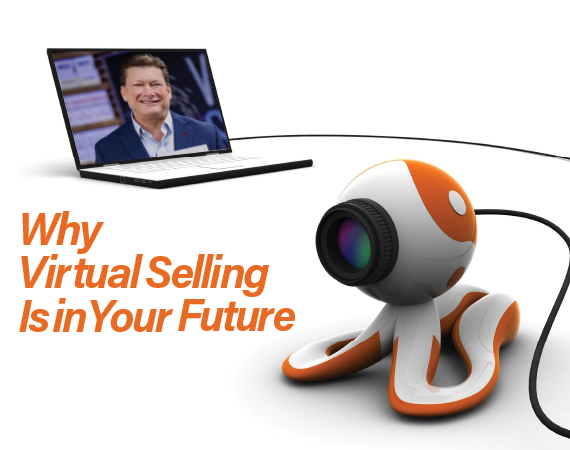Jeb Blount is the bestselling author of 10 books on sales, leadership, and customer experience. An in-demand speaker, he spends more than 250 days each year delivering speeches, workshops, and training programs to high-performing sales teams and leaders. Through his global training organizations, including Sales Gravy and Innovate Knowledge, Blount advises many of the world’s leading organizations and their executives on the impact of emotional intelligence and interpersonal skills on customer-facing activities, and delivers training to thousands of participants in both public and private forums.
The COVID economy has forced many manufacturers in Minnesota to re-think how they deploy their sales teams in a culture that discourages personal contact. How does your book Virtual Selling prescribe solutions to their questions? What’s your elevator pitch?
Jeb Blount: Most importantly, what we’ve learned over the last year is that virtual selling is here to stay. Early in the pandemic, many manufacturers did exactly what they did during the last recession. They shut everything down, cut costs as fast as they could, and just hunkered down to ride it out. That might have worked in other manufacturing cycles, but this recession isn’t like any we’ve ever had. Buyers have changed. They expect more and they expect different. My pitch for manufacturers is that if you don’t start learning how to sell in a virtual environment, you’re going to be at a competitive disadvantage to those businesses that do. A recent McKinsey report on B2B [business-to-business] sales found that 77% of buyers prefer dealing with existing vendors in a virtual environment. Manufacturers who are selling to existing customers should know that those buyers would prefer a virtual interaction than an in-person interaction.
That represents a massive shift. In-person sales are still the best way for us to communicate. It just means that manufacturers and buyers see the same efficiencies in virtual relationships. Salespeople can have a greater impact. They can make more calls and have more conversations. My elevator pitch is this: If you don’t start learning how to master virtual selling, you are going to be at a disadvantage in the next iteration of the economy.
Is it fair to say that the realities of COVID merely accelerated trends in sales management that should have been evolving anyway?
Jeb Blount: That’s exactly right. We’ve basically compressed about 10 years of innovation into 10 months, and that innovation is going to continue to accelerate with the speed of businesses emerging out of COVID.
Describe the path that led you and Sales Gravy into developing the virtual selling instruments in your toolbox.
Jeb Blount: Our path goes back a ways. We were preparing for a virtual environment back in the winter of 2018. We expected there was going to be a recession in the near future, so we sat down and decided to get good at this. When COVID hit, we had already finished our studio. And then we built three more sound studios from the ground up so that we could run sales calls through training to everything. The studio I’m currently sitting in is one of five that we now have in our complex. During recessions, the businesses that we serve in corporate America don’t quit training, they just quit traveling. And if you’re a training company that delivers everything face-to-face, you won’t make it. When COVID hit and everything shut down, we never missed a beat. By deploying our training virtually this year, we doubled the size of our company — both in revenue and in the number of people working for us. Suddenly, we could scale in a way that we could never scale before.
Your book devotes considerable space to the emotional discipline necessary to adapt to a multichannel virtual sales environment. Why is that important?
Jeb Blount: Emotional discipline is at the heart of selling. The human being who exerts the greatest emotional control has the highest probability of getting the outcome that he or she desires in every sales conversation. Virtual selling can create a massive emotional disruption for most people. I have watched people who can easily command a room but lose the ability to speak when they get in front of a video camera and the red light comes on. They get so nervous.
We have to recognize that virtual selling is still selling. If you don’t learn how to manage your emotions in a virtual setting, it will be really hard to convey your message. You can come off as insecure or weak or passive — and that’s not a great place to sell from. You want to be relaxed, assertive, and confident, just like you would in a face-to-face meeting. By managing your emotions, you can influence the emotions of your buyer. These are meta skills for selling. They’re just so much more important in a virtual setting because of the way virtual selling tends to create deep insecurity and vulnerability in salespeople when they’re using those virtual channels.
A consultant at Enterprise Minnesota used to say that the biggest obstacles for progressive change in manufacturing operations come from what he called C.A.V.E. men: Citizens Against Virtually Everything. We all know these people. They are experienced hands who have been around the plant for a long time and have had success doing what they do. And they like doing things the way they’ve always done them, so they resist change. What are the typical C.A.V.E. men arguments against virtual selling, and how do you overcome them?
Jeb Blount: The first argument is that they don’t want to go virtual. We hear it all the time. I was just recently working with a group of manufacturers who said their clients don’t want to meet virtually. I show them that the data say that they do. The salespeople are telling you what they don’t want to do. So, that’s number one. The number two argument is, “I’m not good at it. I can’t make the same connection on a virtual channel that I can face-to-face.” And the third argument is a fear of technology: “I’m not really good at this, and I’m just going to mess things up.” These are basically just excuses. No one is going to argue against the fact that face-to-face is the best way for humans to communicate. But the problem is that it’s not efficient.
And we all know that the history of manufacturing consists of trying to drive efficiency into the system. We want to reduce variables and increase quality, right? We want to get more out of the investments in machines and buildings and people. Virtual selling is about choosing the right sales channel that will give you the highest probability of getting your sales outcome at the lowest cost of time, energy, and money. The C.A.V.E. men have to realize that in face-to-face sales, they can do at most two sales calls a day because you have to get on an airplane or get in your car and drive out there.
But if you use video, you could do 10 calls a day. All of a sudden, you’ve increased your output by five times simply by changing the channel. Sometimes you do have to be there. You have to walk through a customer’s environment or meet his or her designers. But sometimes you have to make sure you’re investing your time and efforts in a way that will get the highest return on investment. The sales team has to start thinking about its production efficiencies in the same way others are thinking about the manufacturing processes. How am I getting the most out of this?
That’s what a virtual system does. Customers are telling us en masse that they prefer virtual. In fact, another good statistic is that 71% of customers say they prefer that the early conversations with new vendors be virtual. Why? Because it’s a lot more efficient than meeting someone you don’t know, bringing them in, going through security, having a cup of coffee, and spending an hour in your office only to find out that this is not the right fit for you.
Your book talks a lot about how to blend synchronous and asynchronous sales tools. How much of a virtual system depends on the art of finding a working equilibrium between them?
Jeb Blount: A good bit of it is art. Finding the right mix depends on your experience. Let’s go back to your C.A.V.E. men. The good thing about C.A.V.E. men is that they are experienced. If they can step out of their self-imposed limitations, they can start making really good, nuanced decisions based on their perception about what’s important to this customer. What’s the best way to convey this message? How do you do this? When do you do it? Why do you do it?
My message to sales organizations is that virtual selling is selling. There’s a system. The science of selling hasn’t changed. Run your system. The art’s going to be in finding the best communication channel for a particular customer in order to achieve a particular outcome.
Is there any danger that increased reliance on technology dilutes the concept of relationship selling?
Jeb Blount: No. Selling is human to human. The relationship comes first, which is why I spend so much time on emotions. We can’t allow our relationships to be diluted by distance or thinking that distance-remote selling removes the importance of the relationship.
There are similarities between in-person and virtual selling, but I imagine there are also differences, right? Things like managing eye contact or reading body language. What advice do you offer virtual salespeople about how to comport themselves on video?
Jeb Blount: Our number one goal is to use video to create the closest facsimile possible to in-person communication. Another interesting recent stat is that if a buyer is given the option of video or phone calls in today’s world, he or she overwhelmingly chooses video calls. It feels more human, and that’s what we want. This was not true a year ago. And that includes dressing for a video call the same way you would when doing business in person. Way too many people think that a video call means they can wear a hoodie or sweatpants. There’s something in the human brain that says a video call is like a throw-away. It isn’t. You have to dress for business. Be natural, but dress for success.
And this is not for everybody, but I like to stand up on video calls because we want the person to see all of our body language. Every time I move on screen, it captures your attention. I pull you in, even at the subconscious level. I want to make eye contact. I want to make sure that people can see me from the torso up so they can see my hands. It gives me an ability to demonstrate through my body language that I’m paying attention and to create emphasis through gestures.
What about the technical aspects of virtual selling, particularly on video? What do you advise?
Jeb Blount: Make sure that the person who is watching you feels good about having a conversation with you. Make sure that you’re in a good environment, that you’ve got a good backdrop, good lighting and good sound. If you do a really nice job on video, they’re going to want to schedule the next video call. There is nothing that we’ve done here that you couldn’t learn on YouTube. It’s simple. But there is a cost. What I use is not inexpensive, but you can get a TV at Walmart for $600, a webcam for $300, put your laptop on a stand for $49, spend $70 for a good ring light. And there are multiple ways to run microphones. My book, Virtual Selling, has some links to different resources for doing that.
I’m guessing that some people might undermine their presentation with inappropriate backdrops.
Jeb Blount: You want your backdrop to be professional. It needs to connote your personal brand. Backdrop replacements don’t work very well and result in poor lighting. You need to have good lighting in front of you, not behind you, or else every time you move, you break the background. There’s nothing wrong with a background replacement, you just need to get your lighting right.
How much of an obstacle is integrating demos into these video presentations?
Jeb Blount: Let’s just say, I’m in a plant, doing a demo. I would probably grab an Osmo — a hand-held apparatus that attaches to an iPhone to provide steady camera shots. Or you could have someone just hold a GoPro and carry it around with you. You take me on the line and you’re going to show me what you’re doing and how you are doing it.
If I turn around or if I’m in front of it, I may have someone else hold it. Then I have the camera facing me, as I can turn the whole camera mechanism around so I can see your face and you can see me. And then we just walk through a demo, which you can do in your office, you can do anywhere. You could even put it on a stand. If you’re by yourself and you put the gimbal on the stand, it uses facial recognition. Once it’s set up and you’re moving around, it will follow you around in your office.
Being able to do demos is especially important in manufacturing. Our clients who sell machine tools and manufacturing tools, they’re doing the same thing. They’re bringing manufacturers in and they’re doing hands-on demos of machines using technology like this. But at a minimum, if you don’t have such an apparatus, get a buddy to hold the phone. So, you shouldn’t let anything get in your way of doing demos. And if you’re on a Zoom call with somebody, they can ask, “Hey, can I get a closer look at that?” Yes. “Can you hold that up for me?” Yes. If you get good at virtual, it allows you to cut down any geographic barrier and you can sell anywhere in the country, anywhere in the world, because now you can do demonstrations to anyone.
You are a fan of video messaging sales tools. Talk about that.
Jeb Blount: Video messaging just works. One of the reasons it’s powerful is that not a lot of people are doing it. Everybody uses video. Most manufacturers probably have video on their websites. They show their processes, systems, and maybe their executives talking about the business they do. It’s meant to be viewed by a lot of people. It carries a wide message and can be seen anywhere in the sales process. Say, for instance, you ask for an appointment. You could then send a video message to say, “Hey, looking forward to meeting with you.”
It’s a one-to-one video that is made specifically for you. It’s powerful because it’s personalized. It’s powerful because it connects with people. That’s why video works so well. When you create a personalized video message, you grab attention that rises above your competitors. People respond. Just a couple of weeks ago, we were doing a session for a manufacturing company. One of their reps said he didn’t know if he could do a video message. I challenged him to create a video message and send it out. Seven minutes later — while we were still in session — the company got a response from a prospect who wasn’t returning any of their calls. It was that powerful. I suggest everyone learn how to use video.
In the midst of discussing all of this technology, your book has a chapter titled, “Pick Up the Damn Phone.” Are you suggesting that salespeople tend to forget the value of the telephone?
Jeb Blount: No doubt. Alexander Graham Bell kicked off modern virtual selling when he made the very first phone call in 1876 saying, “Watson, come here. I need you.” The phone has been the salesperson’s number one tool for well over a hundred years. And it will continue to be our best tool because it’s the easiest, fastest way to connect with people. There’s one of these things attached to almost every human being on Earth. So, yeah, pick up the phone and talk to people. We can get hung up on all of these other things and forget that if we just pick up the phone and call our customers, those conversations, in many cases, can turn into revenue.
…
Featured story in the Summer 2021 issue of Enterprise Minnesota magazine.


